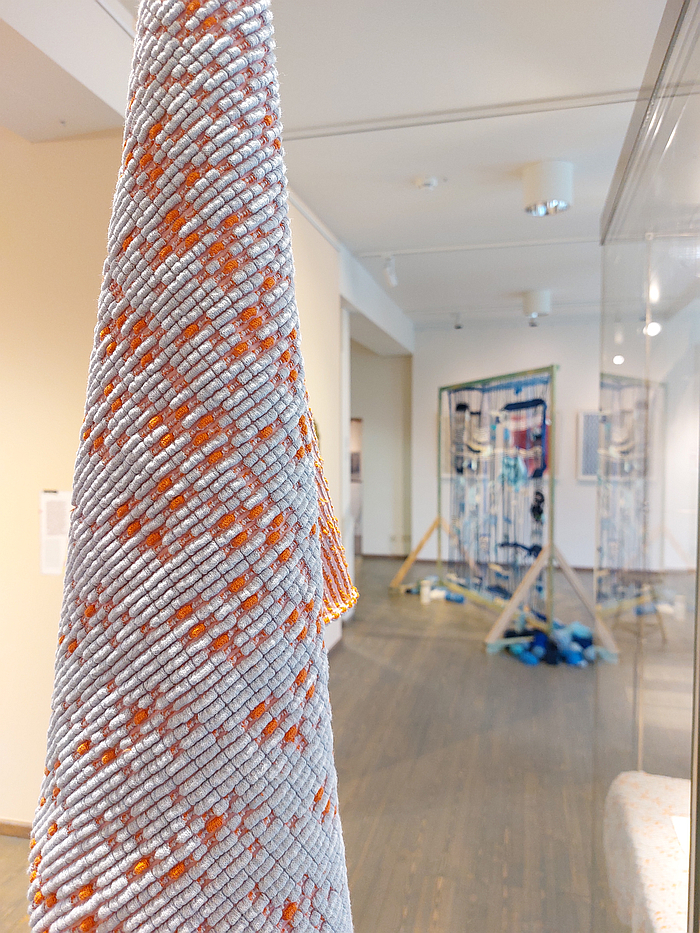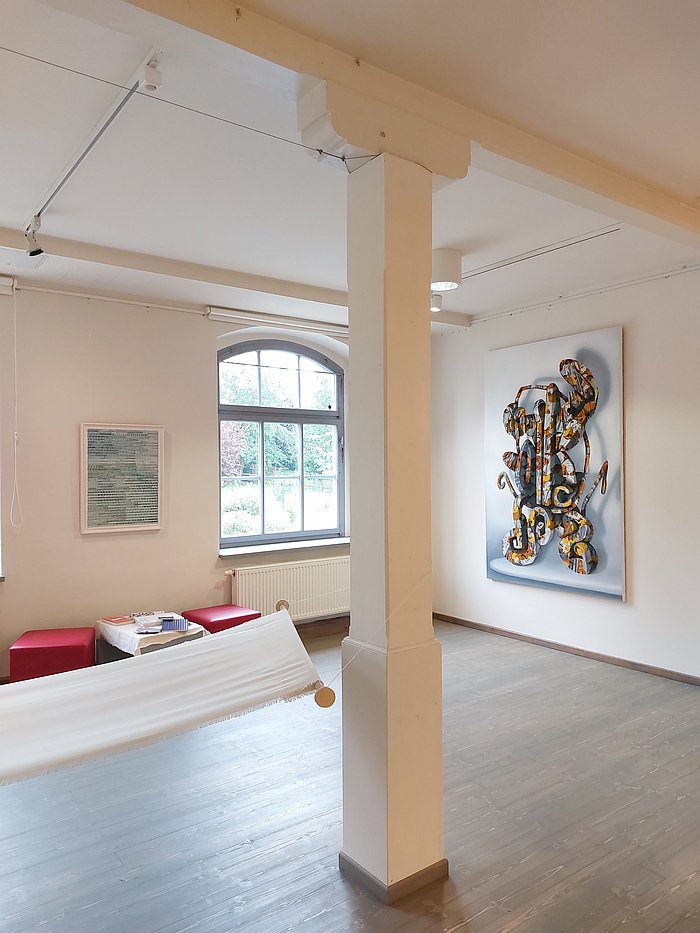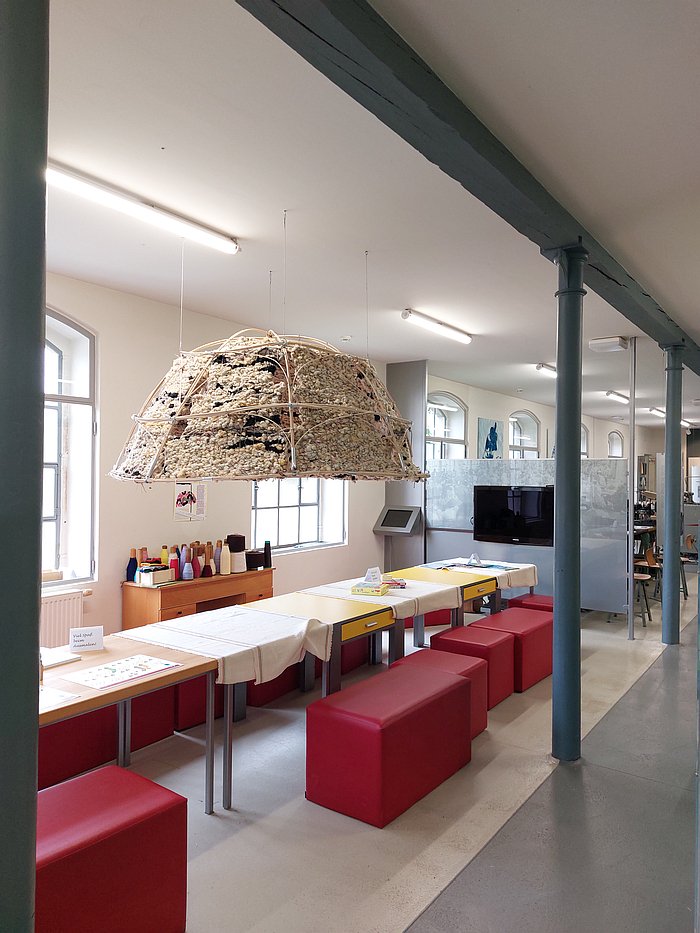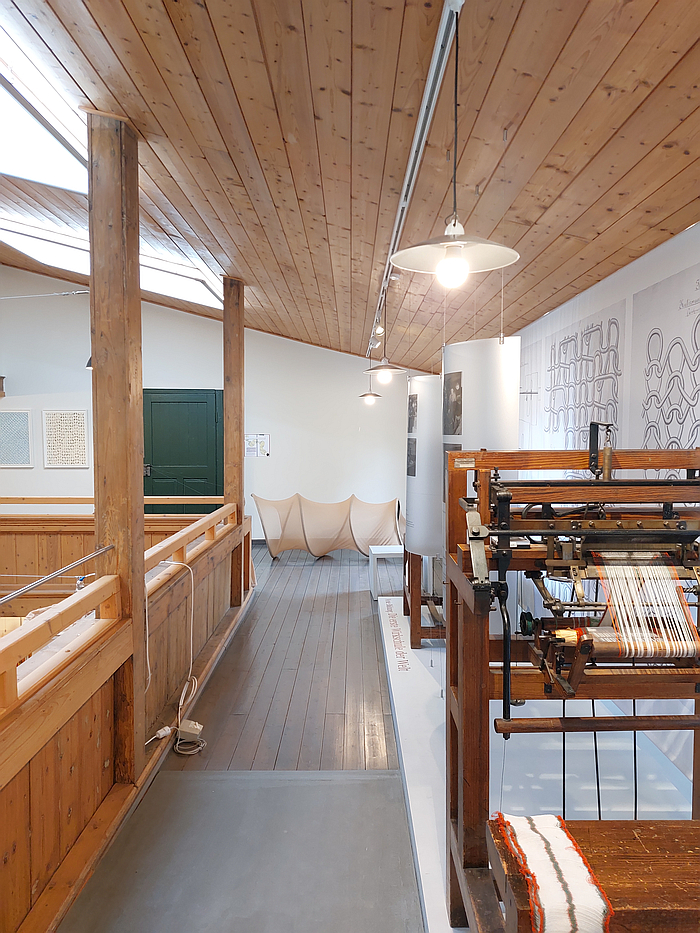Our objects of daily use are never just their physical functions and properties, they always have non-physical agency, always have functions and properties beyond the physical. Albeit non-physical functions and properties that are often masked by a primacy afforded the physical function and properties in our viewing of our objects of daily use.
With Fabric Visions // Textile Visionen the Esche Museum, Limbach-Oberfrohna, provide a space in which to explore and approach textiles beyond the material.......

Situated to the north-west of Chemnitz, Limbach-Oberfrohna is one of those towns whose textile industry has contributed to the leading role played by the region around Chemnitz in not just the (hi)story of textiles but in the development of textiles and in the development of the textile industry. A Limbach-Oberfrohna textile industry that today is, somewhat inevitably, much smaller than it once was, but whose former scale can be understood in the cacophony of chimneys in Horst Schieke's 1948 painting of Limbach-Oberfrohna that hangs in the Esche museum's permanent exhibition. Each chimney, one can argue, being a textile mill.
And somewhere amongst those chimneys are those of the mills of family Esche, those textile barons whose wealth not only helps elucidate the success the textile industry in the region around Chemnitz once enjoyed, but also saw them in a position, as discussed by and from, Reform of Life & Henry van de Velde mittendrin at the Kunstsammlungen, Chemnitz, to commission van der Velde to build them a villa high on Chemnitz’s Kapellenberg, and to build Chemnitz a lawn tennis club. And Esches' whose former stocking mill in Limbach-Oberfrohna today houses the Esche Museum, an institution devoted to the (hi)story of Limbach-Oberfrohna and the (hi)story of textiles in Limbach-Oberfrohna.
A (hi)story of textiles in Limbach-Oberfrohna that also includes the Malimo materials, and Malimo machines, developed in Limbach-Oberfrohna in the 1950s by Heinrich Mauersberger, an important moment in the (hi)story of textile design discussed in detail in the permanent exhibition. And Malimo material that forms the starting point of Zürich based Zoe Köbrunner's project Narrative Layering in which lengths of Malimo fabric have been layered with a glutinous glue to a material that resembles petrified Malimo, a freezing in time for all time of a moment in the (hi)story of textile design not just in Limbach-Oberfrohna but internationally that also allows the material to echo the mill building that stands proxy for the mills in which it was originally produced, to blend the material building with the building's material, and the associated questions of permanence and transience such a blending, echoing and petrifying stimulates.
Questions of permanence and transience also very present in Leipzig based Wilhelm Frederking's Zeitgeist II, an examination, an approaching, via a fictional artefact of a fictional lost nation. An artefact and nation that on closer inspection and reflection aren't that fictional: Frederking employing as the basis for his work a fabric produced in the DDR in the 1970s in context of the renovation of a Baroque mansion, thus allowing you to choose if the lost, but still very present through its artefacts, nation is the 17th century eastern Germany the material was produced to recreate, or the DDR it is was produced in? And if the artefact in question is one of Frederking's, the DDR's or the 17th century's making? Or of all three's?
Thoughts which then take one from permanence and transience to continuation.
An ever fascinating triangle within which to move and to approach questions on society and objects of daily use.

The (hi)story of textiles, as with the (hi)story of the society that requires and produces those textiles, is one of ever novel technology, novel technology that augments established processes and materials thereby enabling novel possibilities with the existing.
Something reflected on in both Berlin based Caroline Kryzecki's paintings which take the tightly gridded so-called point paper on which textile designs were once sketched and from which the punchcards that controlled the automated looms were subsequently created, thus a clearly identifiable step in textile's move ever further away from an artisan craft to an automatised industry, and, digressing slightly, punchcards that, lest we forget, are also intimately linked with the development of digital computer technology and thereby further reinforcing textile's place in the centre of human society... paintings which take tightly gridded point paper as the basis for abstract art works that although apparently limited by the strict grid of the point paper employ that limitation to deconstruct the confinement and standardisation it seeks to impose, an important lesson; and in Aachen based Svenja Bremen's Eierschecke which, if one so will, re-imagines the transferring of patterns from point paper to punchcard, the process of coding a cultural entity, via a self-developed Morse-esque alphabet that is physically rendered in lengths of textiles as a nubbled, braille-esque document that can be read by all familiar with the alphabet and the associated rules of grammar and punctuation.
Specifically Bremen has woven the recipe for Freiberger Eierschecke, a variation specific to the town of Freiberg, Sachsen, on a curd based tray-bake widely produced in the east of the contemporary Germany, and thereby has not only created an engaging pattern via an essentially surrealist methodology, one that can be re-worked infinitely through choosing an alternative text as the basis, but also allows for reflections on textiles as components of collective and individual memory and identity, of the social and cultural associations textiles bring forth.
Whereby, yes, there is a whiff of something backwardly kitsch in the coding for a product such as Freiberger Eierschecke, albeit packaged in a very self-confident, forward looking structure. A past and future in dialogue in Eierschecke arguably not present in Freiberger Eierschecke.

A past and future in dialogue that is however inherent in Crouching Aphrodite by Leipzig based Klara Meinhardt and Unweaving Machine Type II by Berlin based Lars Preisser.
The former, research with the cyanotype process, a photographic, reproduction, process originating in the mid-19th century, more or less contemporaneous with the building of family Esche's mill in Limbach-Oberfrohna in which Meinhardt's Crouching Aphrodites now hang, albeit in Meinhardt's work involving the use of novel UV reactive yarns that family Esche not only had no access to but would be unable to comprehend were an actual thing, weren't something to be feared as a work of wizardry. Yet which if embraced would greatly expand the possibilities of what textiles can be, how textiles can be worked. And that thereby also neatly reinforces the (hi)story of textiles and societies as the novel augmenting the existing that is very present, but not uncouthly so, in Fabric Visions // Textile Visionen.
The latter, an installation in which visitors are invited to unweave a length of industrial fabric, are invited to use the processes of creation to destroy, which aside from the very neat metaphor thereby created to the destruction of the natural world inherent in the industrial society that requires and produces such lengths of fabric, and the changes to the social fabric enforced by the rise of such industrial fabrics, also allows space for reflection as you unweave of the necessity, sometimes the involuntary compulsion, to take a step backwards in order to move meaningfully forward. But also the pains, emotional and physical, of experiencing how that which you created is undone before your eyes.
An Unweaving Machine Type II that in requiring two people to operate it — while, one notes, sat on a Rowac-Schemel, that ever genial reminder of Chemnitz’s contribution to the developments of the 20th century — echoes the chapter Working Hand in Hand in the exhibition Textile Manifestos - From Bauhaus to Soft Sculpture at the Museum für Gestaltung, Zürich, with its focus on collaborative working, on textiles and society as being collaborative process. A Working Hand in Hand, a necessity of cooperation, a reminder that the social fabric of society is a collective weave as much as the material fabric of society, also at the heart of Nos vemos en el cosmos, Cielo XIII by Düsseldorf based Sofía Magdits Espinoza: a collective participative weaving project whose primacy of blue and white hues allows the finished work to resemble the Cielo, Sky, of the title.
Whereby one can't help wondering if allowing the visitors to decide if the sky is blue, grey or black rather than defining it as blue, might not be an extension of the participation. Certainly in a contemporary context.
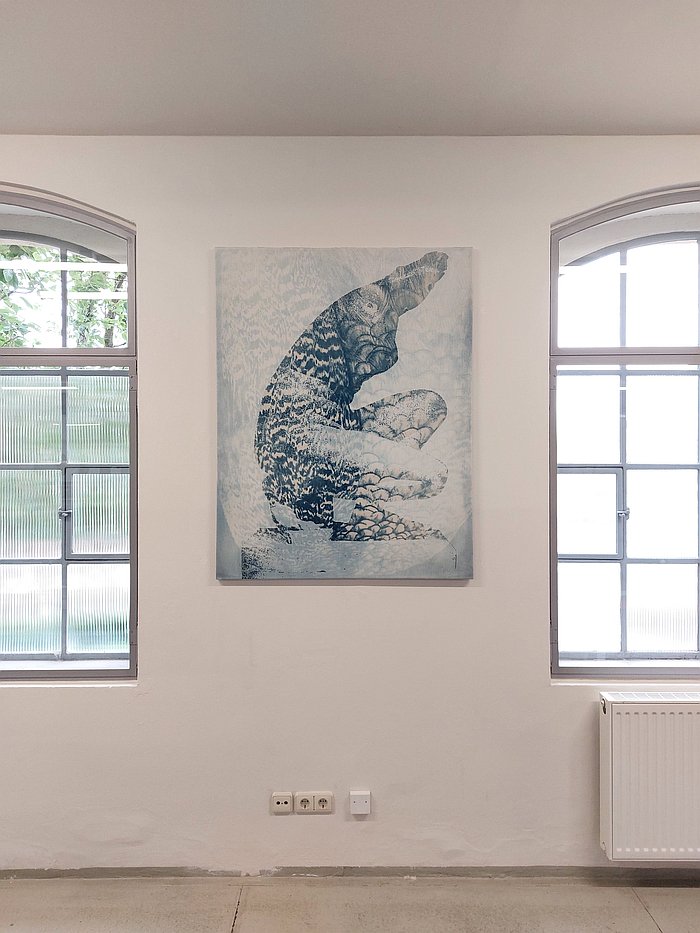
¿Or is that us just being negative and cynical?
Should we not rather listen to the characters Hamal, Wei and Algieba from Rotterdam based Simone Post's Post Human series; three endlessly sanguine, vital and uplifting individuals crafted from textile waste, and, where one can post-ulate...Sorry!!!... that their positivity arises from the delicious solution they have developed to one of the textile industry's, and global society's, biggest and most challenging problems. Whereby, and at the risk of a taking something a little unfairly from the shine of Hamal, Wei and Algieba, for all that finding meaningful uses for waste is very important, in textiles as in all contexts, reducing waste must surely be the primary goal. Identifying why, honestly questioning why, waste arises, and responding to those whys to eliminate waste, must be our primary focus. Is a key component of a responsibility to ourselves and to others that is essential to enabling a functioning global society.
An argument, for us, also very much made by The Raw and the Over-cooked by Berlin based Valentina Karga and Mascha Fehse, essentially a cupola that in hanging over a table defines a space for conversation that in its composition from raw wool — a fibre universally employed as it is, just washed and dyed —, cotton and hemp — fibres won from the processing of natural materials — and a cotton-polyethelyne yarn — an industrial mix of natural and synthetic — not only forces questions on why we use oil-based synthetic fibres in textiles when we have so many natural, renewable, materials to choose from, but also questions why we in Europe don't use more hemp and linen, materials that, as noted in context of the project Moa by Roberta Wende as seen at Design Without Borders, Budapest, 2024, were once one of the most important suppliers of fibres for textiles of all types in Europe before a self-inflicted dependency on imported cotton decimated the production. And also helps highlight that in the majority of European nations wool is a waste product. That for all many nations in Europe, for all those in northern Europe, are keen to promote their woollen industry, for all in context of clothing, one thinks in particular of the great many 'national' jumpers and associated knits that invariably form part of a 'national' identity and a 'national' tourist marketing, such jumpers are invariably produced from imported wool while the local 'national' wool is burned as a worthless waste product. Which is obviously ridiculous.
But also reflective of contemporary society. As are our textiles.
Textiles are reflective of society. Society is reflective of textiles.
Changing one is dependent on changing the other.
Changes in one changes the other.
Changes to textiles and society that start with us, individually and collectively.
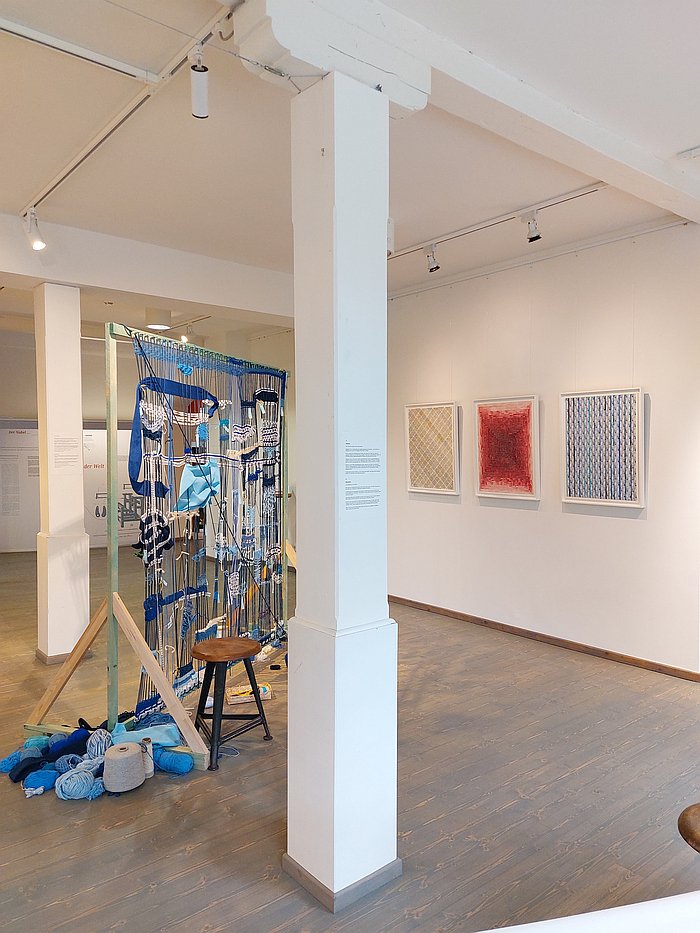
An art exhibition and thus a presentation in which each and every visitor will find their own dialogue with the individual projects, or not, there is never a necessity to like everything just because it is in an exhibition, you pays your money you takes your chance, Fabric Visions // Textile Visionen is a readily accessible bilingual German/English presentation, which very pleasingly is not just presented in the Esche Museum's temporary exhibition space but is also integrated into the permanent exhibtion space thereby underscoring the connection between Fabric Visions // Textile Visionen and the Esche Museum's permanent exhibition; reinforcing not only that the questions posed and perspectives enabled by the presented works should, must, form a component of your viewing of the permanent exhibition, but are already present in that permanent exhibition, just normally unrecognised in the focus on the physical objects.
Whereby a particularly satisfying aspect of Fabric Visions // Textile Visionen is the numerous possibilities for direct interaction with the projects, including with Rotor by Leipzig based Henrike Schmitz, a work that stretches a fabric knitted in the Esche Museum over a spiral form to create an apparently highly fragile object visitors are invited to walk along. And as you do so to reflect on a resilience that is as important in society as it is in textiles.
Invitations to interaction that are a very nice touch in that they effortlessly not only expand the experience of viewing but also allow for even easier access to the works and the questioning, reflection, argumentation on which they are based.
And thereby assist in enabling a presentation that not only provides space for reflections on textiles beyond the physical, on the role and function of textiles in society, on textiles as inherently material and immaterial, but also on the role and function of textile art in all its hues in allowing us to better appreciate textiles and by extrapolation our physical and material worlds, to... and at the risk of sounding like we're shamelessly seeking to curry favour with the curators of Chemnitz's 2025 European Capital of Culture programme by using their motto, which we're not, it just happens to fit perfectly, we'd be daft not to use it... to reflect on the role and function of textile art in allowing us to C_The_Unseen in context of textiles and society, and by extrapolation the role and function of art in allowing us to C_The_Unseen in all our objects of daily use and the society's that produce and employ them.
An Unseen that is as important as the Seen.
A non-physical that is as important as the physical.
Fabric Visions // Textile Visionen is scheduled to run at the Esche Museum, Sachsenstraße 3, 09212 Limbach-Oberfrohna until Sunday November 9th.
Further details can be found at www.esche-museum.de
And further details on Chemnitz 2025 including the full programme can be found at https://chemnitz2025.de
Sincere apologies to Aïcha Abbadi and Ida Westh-Hansen who are part of Fabric Visions // Textile Visionen but whose work we didn't see and didn't realise we hadn't seen it until we were, physically and temporally, a very, very long way away from Limbach-Oberfrohna. No idea how that happened, but it's awful that it did. And a little ironic in context of the admonishments to look carefully inherent in C_The_Unseen. We will try and track the works down and update. Sorry!!!
